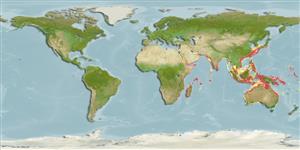>
Gobiiformes (Gobies) >
Gobiidae (Gobies) > Gobiinae
Etymology: Parachaeturichthys: Greek, para = the side of + Greek, chaite = hair + Greek, oura = tail + Greek, ichthys = fish (Ref. 45335).
More on author: Bleeker.
Environment: milieu / climate zone / depth range / distribution range
Οικολογία
Θαλασσινό(ά) βενθικό(ς). Tropical
Indo-West Pacific: south to Natal, South Africa; India (Ref. 4833) and Japan (Ref. 559).
Μέγεθος / Βάρος / Age
Maturity: Lm ? range ? - ? cm
Max length : 15.0 cm TL αρσενικό/απροσδιόριστο; (Ref. 2798)
Short description
Κλείδες προσδιορισμού | Μορφολογία | Μορφομετρία
Ραχιαίες άκανθες (συνολικά) : 7; Μαλακές ραχιαίες ακτίνες (συνολικά) : 9 - 11; Εδρικές άκανθες: 1; Μαλακές εδρικές ακτίνες: 9 - 10. Body greenish; fins dark; upper caudal fin base with a large black spot surrounded by yellow (Ref. 2798).
Parachaeturichthys spp. Inhabit deep water (Ref. 42915). Rarely enters estuaries (Ref. 4833). Captured by trawls over mud bottom (Ref. 11441). Found to contain tetrodotoxin (TTX) and anhydrotetrodotoxin (anh-TTX) which causes paralytic food poisoning (Ref. 54777).
Life cycle and mating behavior
Γεννητική Ωρίμανση | Αναπαραγωγή | Γεννοβολία | Αβγά | Γονιμότητα | Προνύμφες
Masuda, H., K. Amaoka, C. Araga, T. Uyeno and T. Yoshino, 1984. The fishes of the Japanese Archipelago. Vol. 1. Tokai University Press, Tokyo, Japan. 437 p. (text). (Ref. 559)
IUCN Red List Status (Ref. 130435: Version 2024-2)
Threat to humans
Poisonous to eat (Ref. 54777)
Human uses
αλιεία: χωρίς ενδιαφέρον
Εργαλεία
Special reports
Download XML
Διαδικτυακές πηγές
Estimates based on models
Preferred temperature (Ref.
123201): 22.4 - 28.1, mean 26.5 °C (based on 338 cells).
Phylogenetic diversity index (Ref.
82804): PD
50 = 0.7500 [Uniqueness, from 0.5 = low to 2.0 = high].
Bayesian length-weight: a=0.00891 (0.00538 - 0.01477), b=2.92 (2.78 - 3.06), in cm total length, based on LWR estimates for this species & (Sub)family-body (Ref.
93245).
Τροφικό Επίπεδο (Ref.
69278): 3.1 ±0.3 se; based on diet studies.
Ελαστικότητα (Ref.
120179): Υψηλό, ελάχιστος χρόνος για διπλασιασμό πληθυσμού < 15 μήνες (Preliminary K or Fecundity.).
Fishing Vulnerability (Ref.
59153): Low vulnerability (10 of 100).
